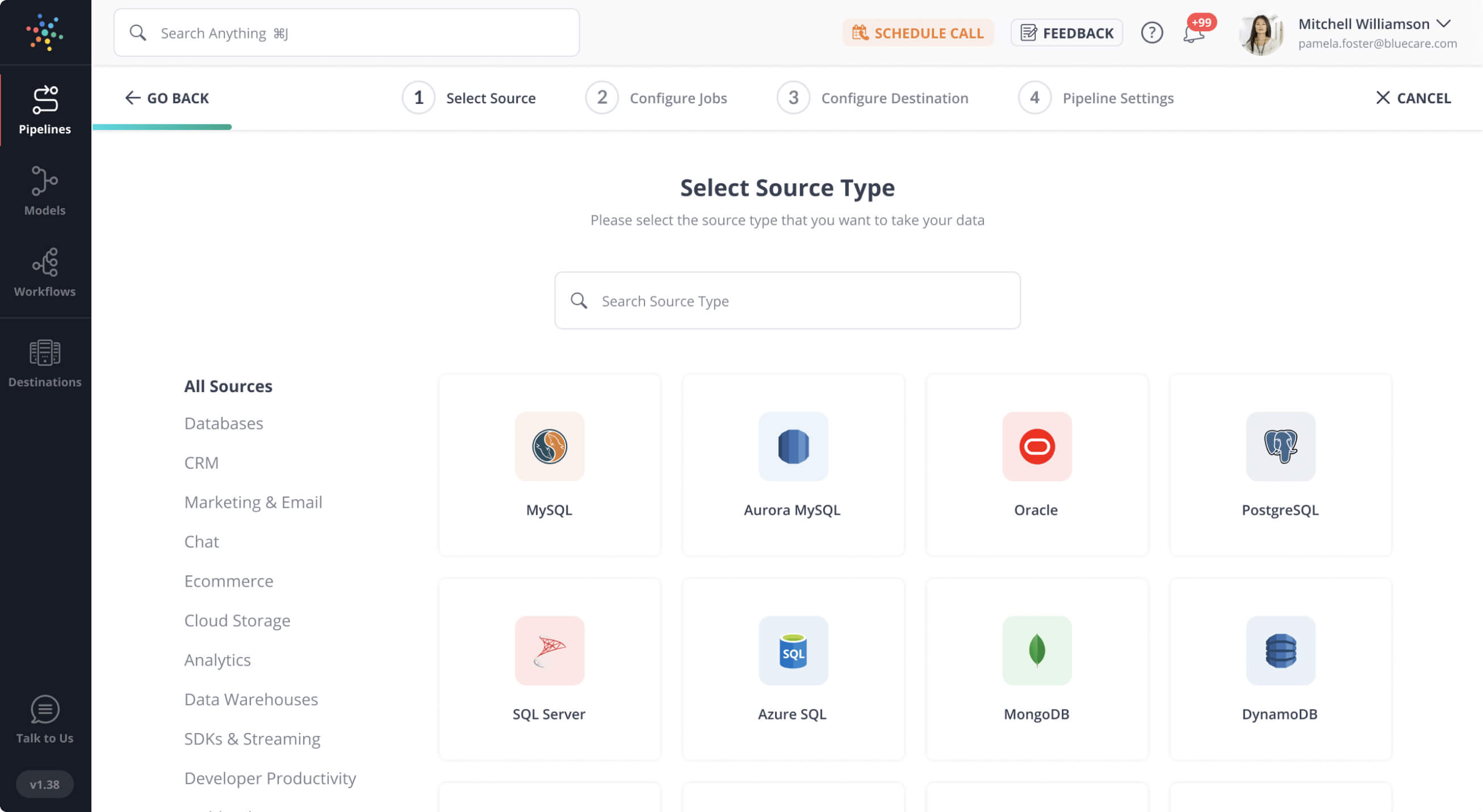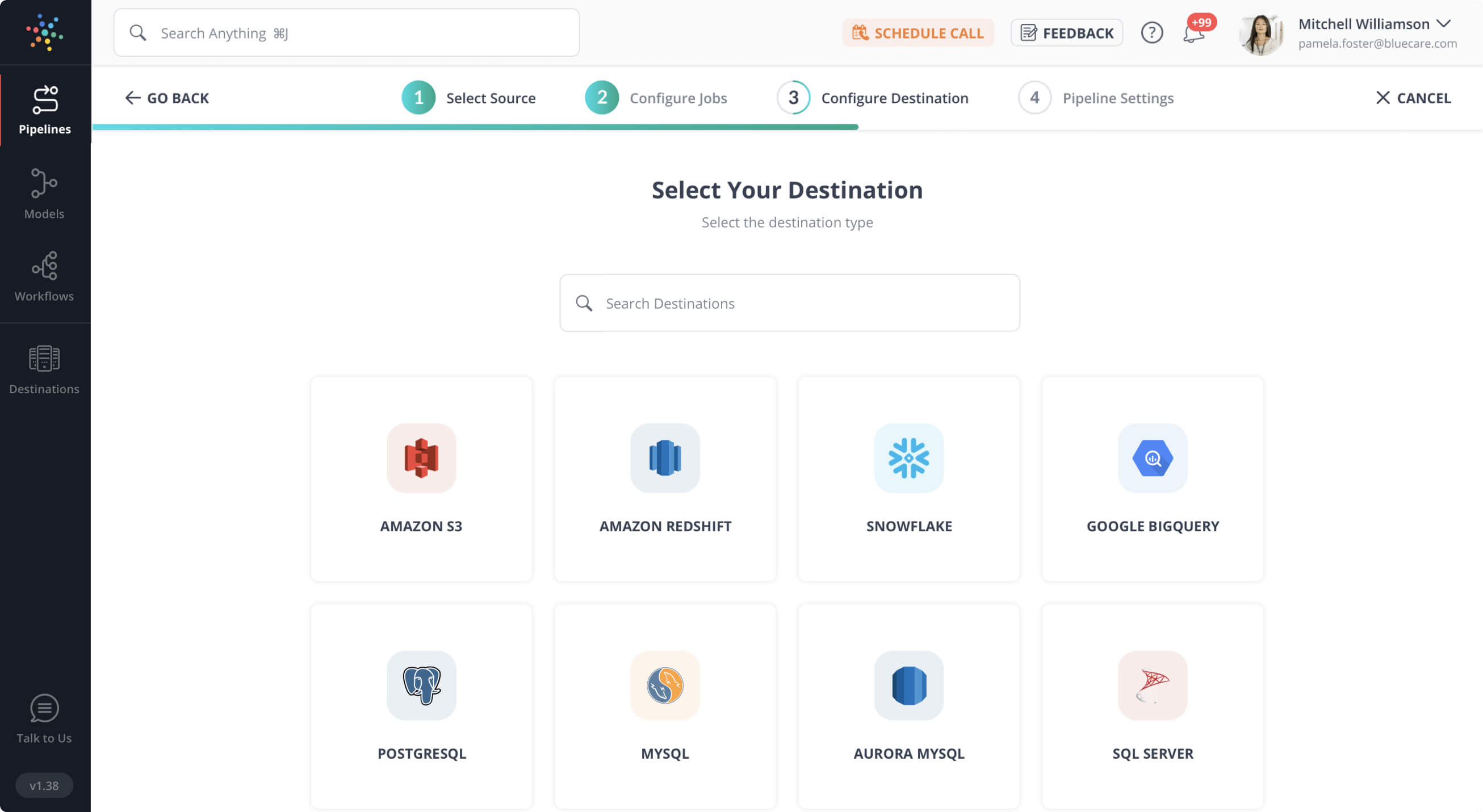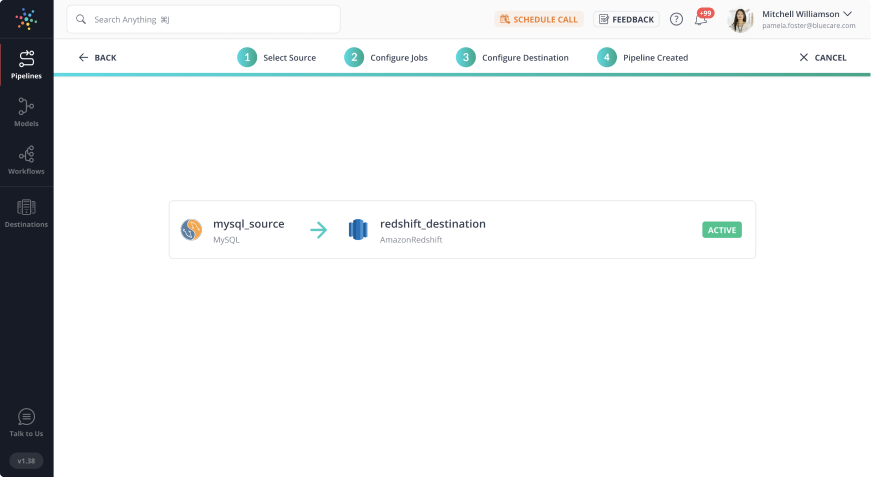 Key takeaways
Key takeaways- Integrating NetSuite with Snowflake enables unified analytics by combining ERP, financial, and operational data in one scalable warehouse.
- You can move data manually via CSV exports for small, one-time loads, or automate replication using a no-code ELT platform like Hevo for real-time updates.
- Hevo’s fully managed pipelines automatically handle API changes, schema drifts, and errors, removing the need for manual intervention.
- Choosing the right method depends on your update frequency, data complexity, and engineering bandwidth.
Integrating NetSuite with Snowflake eliminates data silos and enables deeper analytics across finance, operations, and sales. While NetSuite’s ERP capabilities are robust, its native reporting often limits large-scale analysis. Moving NetSuite data into Snowflake allows teams to combine it with other sources for richer insights, forecasting, and automation.
Here’s a quick comparison of NetSuite to Snowflake integration methods
| Criteria | Automated Connector (Hevo Data) | Native Connector | Manual Export (CSV) |
| Setup Time | Minutes – simple, no-code setup | 1–2 hours – install and configure connector | Several hours – manual export & table setup |
| Data Freshness | Real-time or scheduled syncs | Scheduled batch updates | Manual, infrequent uploads |
| Maintenance | Fully managed, auto-handles schema drift and retries | Moderate – limited customization and support | High – manual rework for every schema change |
| Scalability | Grows easily with data volume and sources | Good for mid-scale needs | Difficult to scale for large datasets |
| Technical Skills Required | Minimal – analyst friendly | Low to moderate – basic setup in Snowflake | High – SQL and admin expertise needed |
| Reliability | Built-in monitoring, alerts, and retries | Stable but dependent on third-party connector | Prone to manual errors and inconsistencies |
| Best Suited Use Case | Continuous, automated data pipelines | Governed, in-account integration | One-time or ad-hoc data migration |
Table of Contents
How NetSuite and Snowflake Work Together
Integrating NetSuite with Snowflake bridges operational data and analytics. NetSuite manages core business processes, while Snowflake provides the scalable, analytical power to transform that data into actionable insights. Together, they give organizations a unified, real-time view of financial and operational performance.
Understanding NetSuite for Data Integration
NetSuite is a cloud-based ERP and business management platform that centralizes data across finance, CRM, supply chain, and operations. It’s a primary data source for revenue, expenses, inventory, and customer records — all critical for analytics.
Key points:
- Acts as a system of record for financial and operational workflows.
- Offers native reports but limited cross-department visibility.
- Data resides in complex tables and APIs that can be challenging to extract at scale.
- Integration with a warehouse like Snowflake helps unlock analytics, forecasting, and data-driven decisions.
Understanding Snowflake for Analytics and ELT
Snowflake is a cloud-native data warehouse designed for high-performance analytics on structured and semi-structured data. It simplifies data storage, transformation, and querying across large datasets.
Key points:
- Becomes a central analytics hub when paired with NetSuite and other SaaS systems.
- Separation of compute and storage allows elastic scaling and predictable performance.
- Handles multiple formats (CSV, JSON, Parquet) and supports real-time ingestion.
- Compatible with modern ELT tools like Hevo Data.
Methods for NetSuite to Snowflake Integration
There are multiple ways to connect NetSuite and Snowflake, depending on your team’s goals, technical expertise, and how frequently your data changes. The right approach balances ease of setup, reliability, and long-term maintenance.
In this guide, we’ll explore three proven methods:
- Method 1: Automated Connector (Hevo Data) – A no-code, fully managed solution that syncs NetSuite data to Snowflake in real time, without manual coding or maintenance. Ideal for growing teams that need automation and scalability.
- Method 2: Native Connector – Use certified apps like Infometry’s NetSuite Connector to pull data directly into Snowflake on a schedule. Best for teams that prefer an in-account, low-code setup.
- Method 3: Manual CSV Export (SuiteAnalytics Connect) – A traditional approach that involves exporting data from NetSuite and loading it into Snowflake. Best suited for one-time migrations or low-frequency updates.
Method 1: Automate the Data Replication Process Using a No-Code Platform
Hevo is a fully managed, no-code ELT platform that makes data movement simple, reliable, and scalable. With fault-tolerant pipelines, transparent pricing, and complete end-to-end visibility, Hevo ensures your data flows seamlessly and stays trustworthy at every stage.
Here’s how Hevo, a cloud-based ETL tool, makes NetSuite to Snowflake data replication ridiculously easy:
Step 1: Sign Up and Log In to Hevo
Create a free account on Hevo Data. From your dashboard, click Create Pipeline to begin the setup.
Step 2: Select NetSuite as the Source
Choose NetSuite from Hevo’s 150+ source catalog.
- Enter your NetSuite credentials (Account ID, Consumer Key, Consumer Secret, Token ID, and Token Secret).
- Hevo automatically validates your connection and fetches your NetSuite schema.
Note: To learn more about how to connect NetSuite as a source, click here.
Step 3: Choose Snowflake as the Destination
Select Snowflake as your target from the destination catalog.
- Add your Snowflake account URL, warehouse, database, schema, and role.
- Hevo securely connects to your Snowflake instance using best-in-class encryption
Note: To learn more about how to configure Snowflake as the destination, click here.
Step 4: Configure Sync and Transformations
- Select the NetSuite tables you want to replicate (e.g., transactions, invoices, or customers).
- Set the sync frequency (default every 5 minutes).
- Apply pre-load or post-load transformations using SQL, Python, or Hevo’s visual editor.
Step 5: Activate and Monitor the Pipeline
Once activated, Hevo continuously syncs your NetSuite data to Snowflake.
- Track sync progress on a real-time dashboard.
- Receive alerts for anomalies, schema drift, or connection issues via Slack or email.
- View logs and retry any failed records instantly.
Step 6: Analyze Your Data in Snowflake
Once synced, your NetSuite data is instantly queryable in Snowflake. You can connect it to BI tools such as Power BI, Tableau, or Looker to generate unified business insights.
Want to see how effortless it can be? Set up your first NetSuite-to-Snowflake pipeline on Hevo and start syncing data in minutes.
Why Use Hevo for NetSuite and Snowflake Integration?
- Automated Data Sync: Seamlessly transfer data from NetSuite to Snowflake with minimal manual effort.
- Real-Time Updates: Keep your data synchronized and up-to-date in Snowflake.
- No-Code Platform: Set up your integration effortlessly without requiring technical skills.
Discover the easiest way to integrate and start integrating NetSuite with Snowflake with Hevo and enhance your data analytics today.
Get Started with Hevo for FreeMethod 2: Using a Native Connector from Snowflake Marketplace
Snowflake’s Marketplace offers native, plug-and-play connectors for NetSuite that can pull ERP data directly into your Snowflake account without needing separate ETL infrastructure.
One popular option is the Infometry NetSuite Connector, but several partners provide similar certified solutions.
These connectors are ideal if your team already works primarily inside Snowflake and wants a native, governed way to sync NetSuite data on a schedule.
Step 1: Access the Snowflake Marketplace
- Sign in to your Snowflake Web UI.
- Navigate to the Marketplace tab in the navigation pane.
- In the search bar, type “NetSuite Connector” or “Infometry”.
- Review the available listings and select a connector compatible with your Snowflake edition and region.
Step 2: Review and Install the Connector
- Click the chosen connector listing to open its product page.
- Review details such as data types supported, refresh frequency, and security notes.
- Click Get Data / Get App and confirm installation.
- Assign the required roles and privileges (usually ACCOUNTADMIN or SYSADMIN) to allow the connector to create schemas and tables in your Snowflake account.
Tip: Always install connectors in a dedicated database/schema to simplify access control and monitoring.
Step 3: Authenticate and Configure NetSuite
- Enter your NetSuite Account ID, Consumer Key, Consumer Secret, Token ID, and Token Secret.
- Select the relevant NetSuite subsidiary or environment (production vs sandbox).
- Test the connection to verify successful authentication and API access.
Step 4: Select and Map Data Objects
- From the connector interface, choose the NetSuite objects or modules to replicate—such as Transactions, Customers, Invoices, or Items.
- Preview the schema mappings the connector will generate in Snowflake.
- Choose full load for historical data or incremental sync for continuous updates.
Step 5: Configure the Sync Schedule
- Define your preferred sync frequency (e.g., hourly, daily, or weekly).
- Enable incremental replication so only changed records are re-loaded.
- Optionally configure notifications or error alerts to be sent via email or Snowflake notifications.
Step 6: Run and Monitor the Pipeline
- Initiate the sync directly from the connector dashboard.
- Track load progress, job status, and row counts within the Snowflake Query History or the connector’s own logs.
- Verify that tables and views were created correctly in your designated database/schema.
- Once data appears, start querying or join it with other warehouse sources for unified analytics.
When to Use This Method
- You already rely heavily on Snowflake Marketplace apps and want a native solution.
- Your team prefers a low-code setup but doesn’t require real-time streaming.
- You need basic automation with scheduled refreshes and governance under Snowflake’s security model.
Limitations Compared to Hevo
- Most connectors refresh data in scheduled batches rather than continuous streams.
- Customization is limited to predefined NetSuite objects and schedules.
- Requires Snowflake Marketplace subscription management and may incur additional credit usage.
Method 3: Replicate Data from NetSuite to Snowflake Using CSV
If you only need occasional data transfers or one-time exports, you can manually export CSV files from NetSuite and upload them into Snowflake. This method requires no third-party tools but involves significant manual effort.
Step 1: Export Data from NetSuite
- Log in to your NetSuite account.
- Go to Setup → Import/Export → Export Tasks → Full CSV Export.
- Click Submit, select Save this file to disk, and download the ZIP file.
- Extract the file to access the CSV data you’ll import into Snowflake.
Step 2: Load CSV Data into Snowflake
- Log in to your Snowflake console.
- Under Databases, create or select your target database and schema.
- Create a new table matching your CSV structure.
- Navigate to Load Data, select CSV, and upload your file.
- Verify the imported data in Snowflake using a quick SQL query.
When to Use the CSV Method
- For one-time or ad-hoc data transfers
- When data volume is small and static
- When no real-time sync or transformations are required
Limitations
- Manual and time-consuming for recurring updates
- No automation or schema drift handling
- High risk of errors during export or import
Manual exports work fine for occasional syncs — but if you need data that’s always up to date, consider automating the process with Hevo.
NetSuite to Snowflake Integration: Real-World Applications
Integrating NetSuite with Snowflake unlocks powerful, data-driven use cases across business operations, finance, and analytics. Here are some of the most common applications:
1. Financial Analytics and Forecasting
Combine NetSuite’s accounting and transaction data with Snowflake’s analytical power to build automated financial dashboards, perform variance analysis, and forecast revenue with precision.
2. Inventory and Supply Chain Optimization
Merge real-time NetSuite inventory data with logistics and sales data in Snowflake to monitor stock levels, identify bottlenecks, and predict demand across locations.
3. Sales and Revenue Insights
Consolidate NetSuite order data with CRM or marketing sources to analyze customer lifetime value, channel performance, and sales trends.
4. Operational Reporting and Compliance
Use Snowflake’s scalable compute to generate accurate month-end or audit-ready reports by aggregating NetSuite data with other business systems.
5. Executive Dashboards and KPI Monitoring
Enable leadership teams to track unified metrics like gross margin, cash flow, and order fulfillment rates in real time through BI tools connected to Snowflake.
Summing Up
Migrating data from NetSuite to Snowflake can unlock powerful analytical capabilities by centralizing your business data in a scalable cloud data warehouse. In this blog, we explored two primary methods to achieve this: the manual CSV export-import approach and the automated pipeline using Hevo.
While the CSV method might suit one-time or low-frequency transfers, it quickly becomes inefficient and error-prone as your data scales. On the other hand, using Hevo offers a no-code, fully managed, and real-time data pipeline solution that simplifies the entire process, ensuring data accuracy, consistency, and minimal maintenance.
If you’re looking for a hassle-free and scalable way to integrate NetSuite with Snowflake, Hevo is the smarter choice. Sign up for a 14-day free trial and start streaming your NetSuite data to Snowflake in minutes.
FAQ NetSuite to Snowflake
1. How to connect NetSuite to Snowflake?
Connecting NetSuite to Snowflake involves several steps:
1. Choose an ETL Tool
2. Configure Netsuite as a Source
3. Configure Snowflake as a Destination
4. Map and Transform Data
5. Run and Monitor
2. Which SQL does Snowflake support?
Snowflake supports several SQL dialects and features that enable flexible and efficient querying of data.
3. Which ETL tool is best for snowflakes?
The best ETL tool for Snowflake depends on your specific needs, but some popular options include:
Hevo: Known for its no-code interface, real-time data syncing, and support for a wide range of data sources.
Fivetran: Offers automated data pipelines and pre-built connectors for Snowflake and other data sources.
Airbyte: An open-source tool with a growing ecosystem of connectors, suitable for various data sources.
4. Can I use SuiteAnalytics Connect (ODBC/JDBC) to move NetSuite data to Snowflake?
Yes, SuiteAnalytics Connect allows you to query NetSuite data via ODBC or JDBC drivers. However, this approach requires SQL scripting and manual setup, making it less scalable than automated ELT tools like Hevo.














